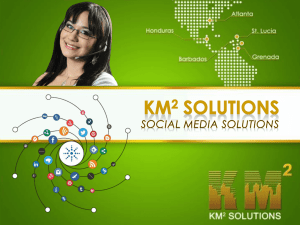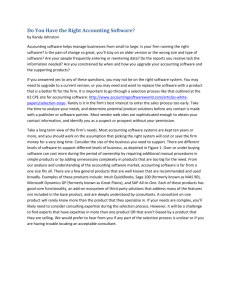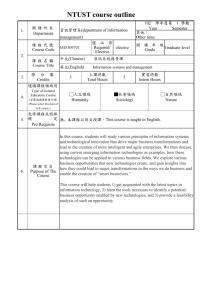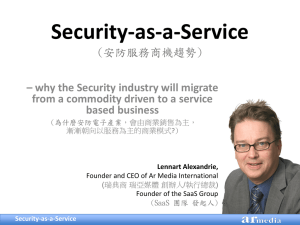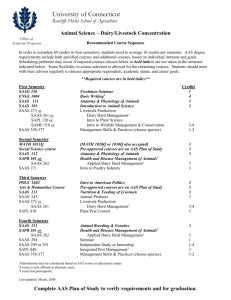Research Journal of Applied Sciences, Engineering and Technology 7(16): 3216-3221,... ISSN: 2040-7459; e-ISSN: 2040-7467
advertisement
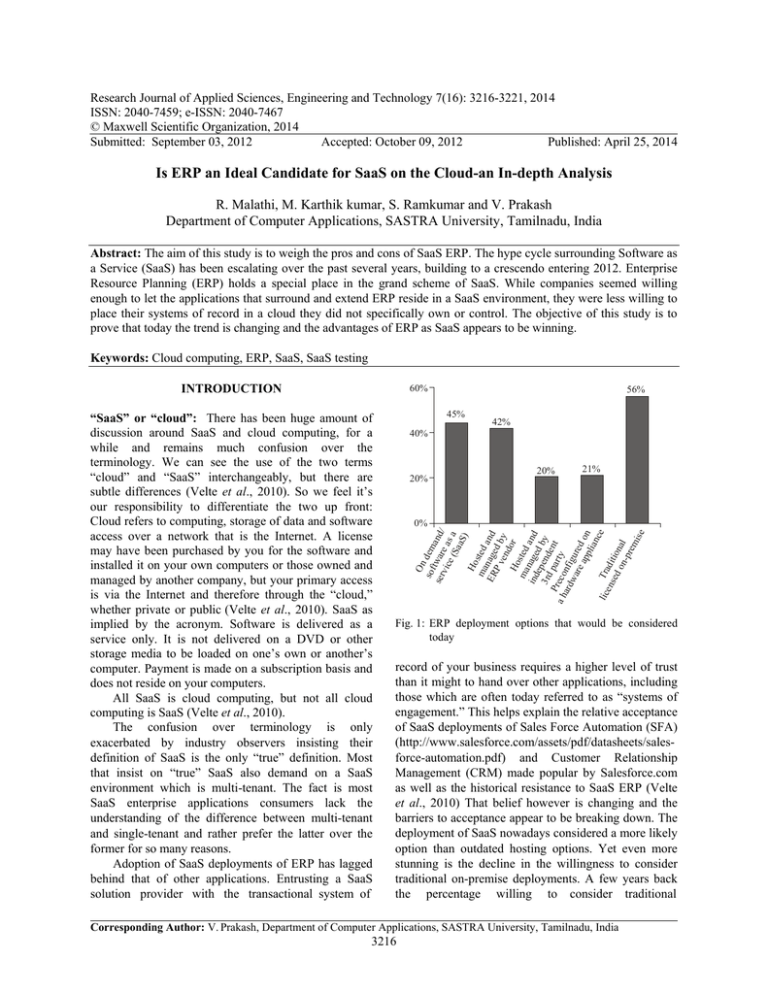
Research Journal of Applied Sciences, Engineering and Technology 7(16): 3216-3221, 2014 ISSN: 2040-7459; e-ISSN: 2040-7467 © Maxwell Scientific Organization, 2014 Submitted: September 03, 2012 Accepted: October 09, 2012 Published: April 25, 2014 Is ERP an Ideal Candidate for SaaS on the Cloud-an In-depth Analysis R. Malathi, M. Karthik kumar, S. Ramkumar and V. Prakash Department of Computer Applications, SASTRA University, Tamilnadu, India Abstract: The aim of this study is to weigh the pros and cons of SaaS ERP. The hype cycle surrounding Software as a Service (SaaS) has been escalating over the past several years, building to a crescendo entering 2012. Enterprise Resource Planning (ERP) holds a special place in the grand scheme of SaaS. While companies seemed willing enough to let the applications that surround and extend ERP reside in a SaaS environment, they were less willing to place their systems of record in a cloud they did not specifically own or control. The objective of this study is to prove that today the trend is changing and the advantages of ERP as SaaS appears to be winning. Keywords: Cloud computing, ERP, SaaS, SaaS testing INTRODUCTION 60% 45% 42% 40% 20% 20% 21% 0% On sof dem ser twar and/ vic e a e( sa Sa a S) Ho s t ma ed ER nage and Pv db end y Ho or s m a te d ind nage and d e 3rd pend by Pre part ent a h co y ard nfi wa gur re e app d on lia n ce lic Tra en s d i ed tion on al -pr em ise “SaaS” or “cloud”: There has been huge amount of discussion around SaaS and cloud computing, for a while and remains much confusion over the terminology. We can see the use of the two terms “cloud” and “SaaS” interchangeably, but there are subtle differences (Velte et al., 2010). So we feel it’s our responsibility to differentiate the two up front: Cloud refers to computing, storage of data and software access over a network that is the Internet. A license may have been purchased by you for the software and installed it on your own computers or those owned and managed by another company, but your primary access is via the Internet and therefore through the “cloud,” whether private or public (Velte et al., 2010). SaaS as implied by the acronym. Software is delivered as a service only. It is not delivered on a DVD or other storage media to be loaded on one’s own or another’s computer. Payment is made on a subscription basis and does not reside on your computers. All SaaS is cloud computing, but not all cloud computing is SaaS (Velte et al., 2010). The confusion over terminology is only exacerbated by industry observers insisting their definition of SaaS is the only “true” definition. Most that insist on “true” SaaS also demand on a SaaS environment which is multi-tenant. The fact is most SaaS enterprise applications consumers lack the understanding of the difference between multi-tenant and single-tenant and rather prefer the latter over the former for so many reasons. Adoption of SaaS deployments of ERP has lagged behind that of other applications. Entrusting a SaaS solution provider with the transactional system of 56% Fig. 1: ERP deployment options that would be considered today record of your business requires a higher level of trust than it might to hand over other applications, including those which are often today referred to as “systems of engagement.” This helps explain the relative acceptance of SaaS deployments of Sales Force Automation (SFA) (http://www.salesforce.com/assets/pdf/datasheets/salesforce-automation.pdf) and Customer Relationship Management (CRM) made popular by Salesforce.com as well as the historical resistance to SaaS ERP (Velte et al., 2010) That belief however is changing and the barriers to acceptance appear to be breaking down. The deployment of SaaS nowadays considered a more likely option than outdated hosting options. Yet even more stunning is the decline in the willingness to consider traditional on-premise deployments. A few years back the percentage willing to consider traditional Corresponding Author: V. Prakash, Department of Computer Applications, SASTRA University, Tamilnadu, India 3216 Res. J. Appl. Sci. Eng. Technol., 7(16): 3216-3221, 2014 56% 58% 56% 39% 20% 22% 19% 22% 34% 18% 23% 22% 20% 30% Upper mid Large enterprise 49% 46% 42% 48% 51% 59% 60% 37% Small Lower mid 90% ma Host n a ed E R g ed b an d Pv yy end ou or r Ho ma sted ind nage and epe d b p nde y P r e a r ty n t a H confi W gur app ed lia on nce lic Tra en s d i ed tion on al -pr em ise On de (Sa mand aS / ) 0% Fig. 2: SaaS ERP increasing trend deployments would have been in the 90’s while recent research pegs it at 56%. As shown in Fig. 1. And before you assume SaaS deployment is just for small companies, consider Fig. 2. The willingness to consider SaaS ERP actually increases as companies grow, with the highest level of interest from large enterprises, which are also the least likely to consider traditional on-premise deployment. More on this as we actually weigh the pros and cons. In spite of the past reluctance to consider SaaS ERP (Purnendu and Gunasekaran, 2003) the plus side of the SaaS equation extends beyond the obvious advantages of outsourcing the care and feeding of the hardware and software involved. And yet there are some lingering concerns, some more valid than others. METHODOLOGY Cost considerations: When we conduct a survey, respondents were asked what they found appealing about SaaS ERP, cost factors stood up to the top of the list. While more than half (52%) quoted lower Total Cost of Ownership (TCO), 46% also observed lower startup costs. A Chief Financial Officer of one small company that decided on the SaaS route 2 years ago noted the estimated up-front investment in an on-premise solution for eight users was $ 150,000. This was primarily for implementation services, but also included hardware and software. The actual up-front cost for the SaaS solution chosen was less than $ 100,000 and allowed up to 25 users. While software and service costs and even pricing models will vary from one solution to the next, this differential is not atypical. This CFO explained, “While the up-front costs were lower we also compared the ongoing costs per year. For (the on-premise) solution, we anticipated annual maintenance costs of $ 10,000/year, but we also knew we would have to invest in a data base administrator/programmer. We conservatively projected that cost to be $ 75,000/year. We compared that to the $ 45,000/year subscription cost for the SaaS solution, with no IT staff required. So, on an ongoing basis we would save on the order of $ 35,000 to $ 45,000 a year. But the advantage of not having consultants living in our offices or an IT department…priceless." In fact 42% of our survey respondents mentioned the lower (or nonexistent) cost of Information Technology (IT) staff as an advantage of a SaaS solution. Many simply don’t have the internal staff they feel are required to adequately support hardware, infrastructure and software and are not interested in investing in these resources. And yet, in noting concerns over SaaS, 15% did indicate they had already invested in IT and were unwilling to reduce staff. Yet it is not unusual for these IT staffs to be kept on board even after a switch is made from on-premise to SaaS. This is far less likely to occur if existing IT staffs have outdated technical skills or if the IT department cannot transform itself from having a tactical focus to one which is more strategic. While the perception of lower costs was quite dominant, 18% did express the sentiment that they did not feel SaaS was any less expensive. In fact some industry observers will confirm this belief citing the obvious “rent versus buy” (Hammond, 2011) mentality and will point to break even points in the five to seven year range (Michael, 2008). However, these calculations only take into account the cost of the software and maintenance and usually ignore the cost of the hardware and often the middleware (i.e., database and infrastructure) that supports the application, not to mention the IT staff needed to maintain it. Certainly if ERP is the only application that moves to the cloud and other applications remain on-premise, hardware (and IT staff) will still be required. However, the power and storage capacity needed will necessarily be reduced. Often today, as older hardware and middleware is replaced, the ongoing costs are significantly reduced with the added price performance of newer technology. One final cost concern that needs to be considered is that of escalating costs over time. Using the same “rent versus buy” analogy, (Hammond, 2011) long gone are the days of “rent-controlled apartments.” You sign a lease and take your chances that the landlord will not raise the rent through the roof at the end of the term of the lease. But once you make a purchase of a condominium or a house, there are no guarantees that your taxes won’t escalate out of control either. The software equivalent to property taxes is maintenance. However, there are some notable differences between real estate and software. Both maintenance fees and the software that is delivered as a service are governed by contracts. It is important in selecting a solution provider to look at the historical 3217 Res. J. Appl. Sci. Eng. Technol., 7(16): 3216-3221, 2014 escalation of cost and you may even want to negotiate a limit to allowable price increases. Preserving your investment: Second only to TCO, 48% of respondents included the reduced cost and effort of upgrades as an advantage to SaaS. The availability of leading edge technologies through more frequent updates also factored heavily for about 39%. This too will vary from one vendor to the next and in fact those that provide the same solution in both SaaS as well as traditional on-premise deployment options may continue to deliver innovation in a traditional way. However even in this case, it is the responsibility of the SaaS solution provider to bear the burden of the upgrade process. And at least some of the SaaS-only solution providers provide far more frequent and apparently seamless upgrades. Although the upgrade process is viewed only on the positive side of the SaaS equation (Tyner, 2008). A negative view by some may also exists. Twenty-six percent of respondents cited the concern that they lost control. It is true that in a multitenant environment, the customer typically has a very little control over the timing of the upgrades. However what is the real impact? If innovation is delivered in such a way that the customer may optionally choose to take advantage of an enhancement- or not -then there is no down-side and a lot of up-side. In many cases “We want to control our own upgrade process” actually translates to “We don’t have time” or “We don’t want the disruption of an upgrade.” And yet by not keeping a look on the latest release of the software you are essentially allowing your maintenance money going waste. It is true that in a SaaS environment, those would be your subscription dollars. Even though upgrades at first might feel like a forced march, that forced march is actually good for you. All bug fixes and regulatory requirements are in place. When you are ready to turn on the new functionality, it will be there. So the combination of frequent updates and this “opt in” capability is an ideal characteristic which evaluate potential solutions. Customization: Heavily customized solutions also may prevent companies from keeping current on the latest release of ERP. At the same time, the perception of the need for customization may present a barrier to considering a SaaS solution. As a matter of fact 25% of our survey respondents cited the requirement for heavy customization would prevent them from considering SaaS. Yet there are some very valid arguments that can be made against this as a barrier to SaaS entry. First of all, don’t necessarily assume you can’t customize a SaaS ERP solution. Most modern ERP solutions today offer so many options to configure and tailor the solution that users think they are performing customizations, even though they are not touching the code or building barriers to future upgrades. And if the requirement does truly require code modification, some (but not all) SaaS vendors, even some which provide multi-tenant solutions, do indeed support customization. These vendors either: • • Incorporate the customization into the standard product, possibly with switches and settings that effectively “hide” the changes from other customers or make them optional They offer the customized solution in a singletenant (multi-instance) environment Yet while many individuals may think their business is unique (thus making customization necessary), much of what they do can and should be quite similar to any other business or at least similar to other businesses in the same industry. Perceived differences often spring from the “we’ve always done it this way” mentality. And those supposedly unique business processes may pre-date the availability of tools and technology that can improve the process. But if you truly require heavy customization, then it may be time to reevaluate whether you have the right solution for the job at hand. In selecting ERP, fit and functionality has always been the top priority, as it should be. Our survey respondents ranked this criterion at the top of the list at 3.49 on a scale of 0 to 4, where 4 is “extremely important.” But sharing that top spot, tied at 3.49, was ease of use. These two criteria actually can and should go hand-in-hand. Even with the best fit, if the solution is not easily navigated, if it doesn’t allow you to work naturally, if it doesn’t save you time and effort, then it simply won’t get used and it won’t produce value for your business. For those with existing ERP solutions that require continued support of heavy customization, it may be time for a replacement and SaaS may help pave the way. In the not too distant past, ERP was thought to be like brain surgery. Don’t do it unless the patient is dying. But today, it should be viewed more like joint replacement. If your knee or hip is not functioning properly, typically you will delay replacing it until you exceed your threshold for pain, or until you are no longer able to function properly. Use this same philosophy in terms of ERP. While it still may require major surgery for your company, recovery may be speedier with a SaaS solution. Survey respondents with SaaS implementations reached their first go-live milestone 19% faster than those with on-premise solutions. There is still the perception among some (23%) of our survey respondents that SaaS ERP solutions do not 3218 Res. J. Appl. Sci. Eng. Technol., 7(16): 3216-3221, 2014 offer the same level of robust functionality that onpremise solutions provide. However, there are SaaSonly ERP solutions that are quite mature (look to see how long they have been around). Before SaaS became popular, these vendors often sold their solutions in spite of being SaaS, rather than because of it. Cost and the lack of need for an IT department were often factors, but just as often they won the business largely on the merit of the solution. And today more and more of the ERP vendors that have always offered on-premise solutions are now taking these solutions and offering them with some flavor of SaaS. In comparing any two or more solutions, there may be a varying size gap in fit and functionality, but don’t assume a solution that is on-premise necessarily has more functionality. Carefully evaluate each for its specific fit against your needs. ACCOUNTING FOR COSTS AND RISKS Before making a purchase (or a replacement) decision, you will want to consider how you will account for the costs. If you choose an on-premise solution, with the purchase of a substantial up-front license, the default accounting will be to treat it as a Capital Expense (CapEx). You may have some alternatives through leasing and some on-premise solutions can be paid for through subscription pricing. But generally all SaaS solutions are paid for through subscriptions, giving you the alternative of treating the cost as an Operating Expense (OpEx). Whether this is a requirement or even a preference is a question you must answer along with your accountants. The ability to treat the purchase as an operating expense is often associated with lowering the risk. And in fact the perception of SaaS as a lower risk was cited by 25% of all respondents and 45% of World Class. Lower risk and “pay as you go” subscription pricing however should not be confused with “Let’s try it and if it doesn’t work, we can just walk away.” Make no mistake, the implementation of an ERP solution, SaaS or otherwise, is a major undertaking. It is the system with which you will run your business and there is a high degree of probability it will introduce change to the way you run it. After all, if you are not going to gain efficiencies and improve your business, why do it at all? However there is one risk that SaaS might seem to introduce -that of downtime and unpredictable performance. This concern was expressed by 46% of survey respondents. Here is another example where due diligence is required. Ask for historical performance including outages and down-time and consider asking for guarantees, albeit with the suitable caveats for natural and man-made disasters. However, expect a higher level of commitment than you yourself could make to your own constituents. SaaS solution providers’ very livelihood depends on this and as a result they build in redundancies that you as an individual company could probably never afford (Schubert and Adisa, 2011). Distributed environments: This redundancy is often achieved through backup facilities in different parts of the country or even the world. Yet operating across environments which are distributed evenly has become a way of life for a large percentage of businesses today, even smaller ones and therefore may provide additional incentive to consider SaaS ERP. Actually 67% of all our survey respondents were having more than one operating location served by ERP, but our survey sample included companies sizing from very small to very large. Even smaller companies with annual revenues under $20 million averaged 2.5 operating locations. This average escalated to 10.7 in companies with revenues over $ 1 billion. This level of distributed environment helps us to explain at least why large enterprises are so ready to consider SaaS ERP (Fig. 2). As a better way to control the standardization of solutions and processes than through SaaS deployment available? In fact 36% of our survey respondents stated that the key advantage of SaaS is the ease of remote access for a distributed workforce and 26% of our respondents noted the ease of bringing up remote sites. Of course these distributed environments don’t necessarily rule out other deployment options. Centrally hosted environments might accomplish the same goal, but again the burden of installation and upgrades must be born either by the host or the company itself, whereas the SaaS solution provider can bear much of that burden of responsibility “What is SaaS” (http://www.salesforce.com/saas/.). Integration with other applications: When we consider distributed environments, we also must consider multiple enterprise applications which necessarily co-exist with ERP. Although the footprint of ERP has steadily expanded over the past three decades, it is a rare occurrence for ERP to be the one and only application running in the enterprise. And as the central focal point in running your business, it is likely there will be touch points of integration between ERP and surrounding applications such as Customer Relationship Management (CRM), Supply Chain Management (SCM), Product Lifecycle Management (PLM), Human Capital Management (HCM), to name just a few. Will integration requirements form a barrier to SaaS deployment? While 16% of respondents require integration today, another 22% expect this will be a requirement in the future. But another 35% recognize 3219 Res. J. Appl. Sci. Eng. Technol., 7(16): 3216-3221, 2014 CONCLUSION 40% 35% 30% 22% 20% 16% 16% 10% 10% Wi ll in be re the qu fut ired ure N wi ot re ll b qui e c r ed ons bu ide t r ed No t im po rta nt No t ap con wou plica s of ider ld no ble Sa aS any t sol typ u ti e on Re qui r ed no w 0% Fig. 3: Interoperability requirements with other applications this as a consideration without really understanding what those integration requirements are today (Tyner, 2008) as shown in Fig. 3. While not a particular sticking point today, this is a requirement that must be given careful consideration as hybrid environments begin to develop. Of course, if SaaS continues to develop in popularity as some industry observers predict, interoperability will remain as it is today, an important consideration, but more in terms of integrating with other SaaS solutions. The openness of the platform on which the SaaS software is delivered will become important just as the openness of any operating or development architecture is for onpremise solutions today. And finally what about security? The final and often deciding factor in considering SaaS ERP is one of security. Its one thing to put your sales contacts in the cloud, but quite another to put your system of record someplace where you can’t see it or control it yourself. And yes, the number one barrier to SaaS deployment is concern over security, with 58% of survey respondents expressing this fear. And yes, everyone should be concerned over security. But they should be concerned regardless of deployment option. Don’t make the mistake of thinking an on-premise implementation is necessarily any more secure than SaaS. That is unless your data center is completely banned of any outside access the four walls of your building, which means no VPN access and external consultant or guest never connects their laptops in to your network. There aren’t too many installations, if any, like this in the world today. In fact, if your company is small, without a dedicated IT security expert on board, chances is you assume more risk than you would in a SaaS environment, mainly the ones that has successfully completed an annual SAS 70 Type II audit. While 58% of respondents expressed concerns over security, another 29% admitted that part of the appeal of SaaS had the comfort of leaving security and other major IT issues to the experts. On the average the advantages of a SaaS environment for ERP seem to offset the disadvantages. Cost saving, which includes TCO, startup costs and cost of IT staff are substantial. Even if the subscription cost equals the cost of software and maintenance over time, there are still few savings achieved by eliminating the purchase or continued hardware maintenance. If you don’t have any IT staff today, there is no need to hire a few. If you have good IT staff on board, engage them in more strategic and more value-add activities than regular maintenance. Whether you choose a solution that is multi-tenant or multi-instance, carefully evaluate the solution provider’s approach and track record in terms of delivering innovation. Look for those that update frequently, but provide “opt in” enhancements. And don’t build road blocks to keeping current with excessive customization. Configuring is good. Modifying code and then having to continue to maintain that code is bad. If you still think you need to customize, ask yourself if you have the right solution. If you are operating in a distributed environment, consider about the advantages a SaaS environment can bring in terms of standardization throughout the enterprise, providing access to employees located in remote and bring remote sites up quickly. If you have already invested or intend to invest in other applications that surround or extend ERP, consider the integration requirements and capabilities of the solutions you examine. The accounting advantages of CapEx vs OpEx (http:// www.diffen.com/difference/Capex_vs_Opex) may or may not be appealing to the office of the CFO. But ask the question and make a conscious decision, rather than letting your choice of solution dictate your accounting. And finally assess your risks. Do you have risks today in terms of existing software and its ability to help you manage your business? What new risks does new software add or eliminate. Assess your current level of security. When considering SaaS solutions, look for data centers that have passed a SAS 70 Type II audit and ask yourself if you yourself could pass such an audit today? The depth and breadth of choice between solutions and deployment options have never been greater. Look for these choices to continue to expand. But with more choice comes the requirement for better due diligence and good decisions. Don’t be held back by preconceived notions and misperceptions about technology that is rapidly advancing. Not all SaaS ERP solutions were created equal; don’t treat them as a commodity. Choose careful option that is right for your business. 3220 Res. J. Appl. Sci. Eng. Technol., 7(16): 3216-3221, 2014 REFERENCES Hammond, J., 2011. Rent vs Buy-The SaaS Decision. Retrieved from: http://www.jimhammondblog. com/2011/rent-vs-buy- %E2%80%93- the-saasdecision-%E2%80%93-part-1. Michael, M., 2008. Cloud Computing: Web-based Applications that Change the Way You Work and Collaborate Online. QUE Publications, Indianapolis, USA. Purnendu, M. and A. Gunasekaran, 2003. Issues in implementing ERP: A case study. Eur. J. Oper. Res., 146(2): 274-283. Schubert, P. and F. Adisa, 2011. Cloud Computing for Standard ERP Systems: Reference Framework and Research Agenda. Research Paper Zugänglichunter. Retrieved from: http://kola. opus.hbz-nrw.de/volltexte/2011/702/. Tyner, B., 2008. SaaS Economics. Retrieved from: http://tynerblain.com/blog/2008/08/13/foundationseries-saas-economics. Velte, A.T., T.J. Velte and R. Elsenpeter, 2010. Cloud Computing: A Practical Approach. McGraw-Hill, New York. 3221
